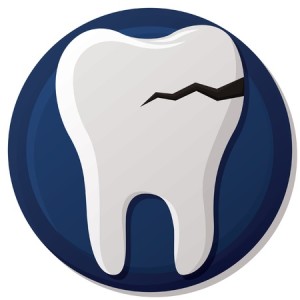How Do I Know If My Tooth Is Cracked?
Cracked teeth can exhibit a number of symptoms including pain and temperature sensitivity. Pain can often be erratic and exhibited when chewing or when the tooth is exposed to hot or cold temperatures. Often it can be difficult to locate which tooth is causing the discomfort because of the sporadic nature of the pain. If you are experiencing pain but are unsure of the cause, book a consultation today to discuss how we can alleviate it, save your natural your tooth, and restore function.
Can Cracked Teeth Heel Themselves?
Unlike fractured bones, teeth cannot heal themselves and, if left untreated, can worsen and become increasingly painful. It is important to discuss the possibility of a cracked tooth with your Dentist as soon as possible to diagnose, treat, and ensure the issue does not worsen.
Types of Cracks
Craze Lines: Very small cracks that affect only the external appearance of the tooth. Extremely common in adult teeth. Craze lines are shallow, cause no pain, and are of no concern beyond aesthetics.
Fractured Cusp: A cusp is the pointed part of the chewing surface of a tooth. It can sometimes become weakened and possibly fractured. The cusp may break off by itself. If not, it will be removed by your Dentist or Endodontist. When the fractured part is removed, pain is usually relieved. Natural function and aesthetics will be restored with a full crown by your Dentist.
Cracked Tooth: A cracked tooth is defined by a crack that extends from the top, the chewing surface towards the root of the tooth. A cracked tooth cannot be split into two distinct parts. It is common to injure the pulp from a cracked tooth. In this case an endodontic treatment (root canal) may be necessary. Your tooth will be restored with a full crown.
It is important to treat a cracked tooth as soon as possible. A cracked tooth will progressively worsen. Early diagnosis and treatment is imperative to saving the natural tooth. If left untreated a cracked tooth can worsen and could result in the loss of the tooth. In some cases a cracked tooth can extend beyond the gum line, in this case the tooth will need to be extracted.
Split Tooth: Similar to a cracked tooth, a split tooth is often the result of a crack but can be separated into two distinct segments. Unfortunately, a split tooth cannot be fully saved; however, the position and extent of the damage will determine whether a part of the tooth can be saved. If part of the tooth can be saved, a crown or restoration will be placed by your Dentist.
Vertical Root Fracture: A vertical root fracture is a crack that extends from the bottom of the root up towards the chewing surface of the tooth. A vertical root fracture can often go unnoticed or show minimal symptoms for a period of time. Eventually, they often become infected and subsequently sensitive or painful. In some cases, endodontic surgery can save a portion of the tooth, but often the tooth will need to be extracted.

